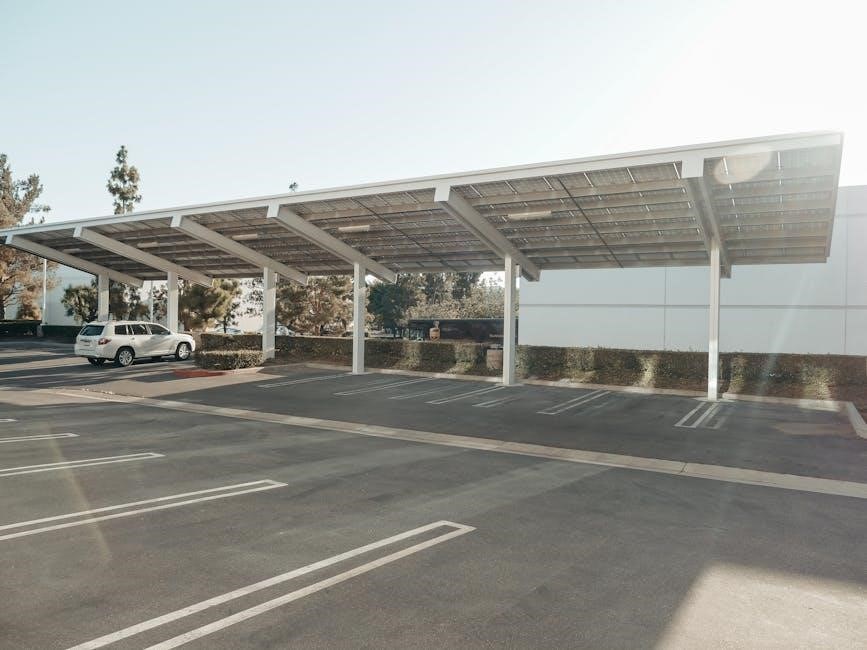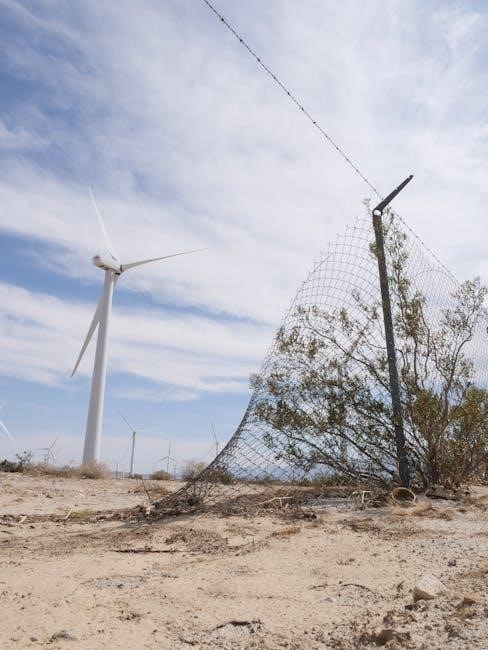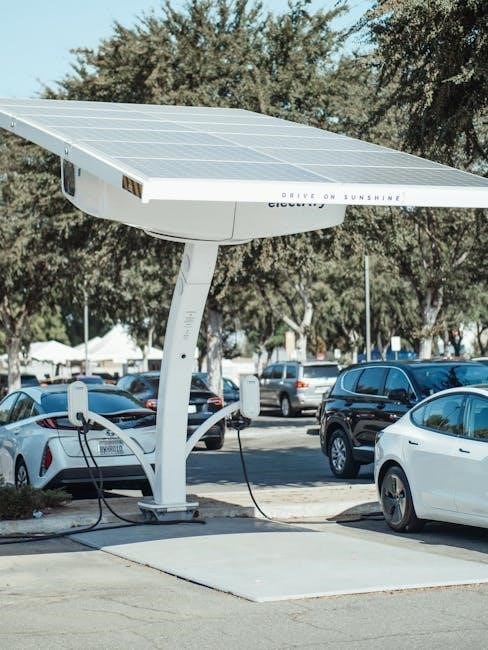generac generator clearance requirements pdf
Proper clearance is essential for safe and efficient operation of Generac generators. NFPA 37 standards and local codes dictate minimum distances from structures, windows, and vegetation to prevent fire hazards and ensure proper airflow. Clearance at the top should be at least 60 inches, while front and side clearances require 36 inches. Generac manuals provide detailed guidelines, emphasizing the importance of adhering to these requirements for optimal performance and safety. Always consult local building departments and authorized service dealers for compliance.

Key Considerations for Installing Generac Generators
Installing a Generac generator requires careful planning to ensure safety, efficiency, and compliance with local and national codes. One of the most critical factors is proper airflow, as generators need adequate ventilation to operate effectively and prevent overheating. Generac recommends maintaining a minimum clearance of 36 inches from the front and sides of the unit, as well as 60 inches from any structures, overhangs, or projections above the generator. This ensures unobstructed airflow and reduces the risk of fire hazards.
Another key consideration is the placement of the fuel regulator, which must be at least 10 feet away from the generator to ensure proper operation and safety. Additionally, the generator should not be installed in enclosed spaces, such as basements or garages, due to the risk of carbon monoxide buildup. Proper ventilation is essential, and generators should be placed in well-ventilated areas to avoid dangerous fumes.
When selecting a location, it’s important to consider the surrounding environment. Generators should be installed on level ground to ensure stability and proper operation. They should also be positioned away from flammable materials, such as shrubs, trees, or other vegetation, to minimize fire risks. Generac guidelines emphasize the importance of maintaining these clearances to ensure compliance with safety standards and manufacturer recommendations.
Electrical connections must be handled by a licensed professional to ensure they meet local electrical codes and Generac specifications. Improper wiring can lead to safety hazards, equipment damage, or even void the warranty. Additionally, the generator should be installed in an area that is easily accessible for maintenance and servicing. Generac recommends contacting an Independent Authorized Service Dealer (IASD) for routine inspections and repairs to maintain optimal performance.
Finally, always consult local building departments to obtain the necessary permits and ensure compliance with local regulations. Generac provides detailed installation manuals and guidelines, but local requirements may vary. By addressing these key considerations, homeowners can ensure a safe, efficient, and reliable installation of their Generac generator.
NFPA 37 Requirements for Generac Generators
NFPA 37 is a standard that provides detailed requirements for the installation of stationary combustion engines and fuel systems, including generators. For Generac generators, NFPA 37 plays a crucial role in ensuring that installations are safe, efficient, and compliant with fire safety regulations. One of the primary focuses of NFPA 37 is the clearance requirements between the generator and surrounding structures, such as buildings, windows, and vegetation.
According to NFPA 37, Generac generators must maintain a minimum clearance of 3 feet (0.9 meters) from any building or structure. This includes windows, doors, and overhangs, as these can pose fire hazards if not properly spaced. Additionally, the standard specifies that generators must be at least 18 inches (0.45 meters) away from vegetation, such as shrubs, bushes, and trees. This is to prevent ignition sources from reaching flammable materials and to ensure proper airflow around the unit.
NFPA 37 also emphasizes the importance of proper airflow for generator operation. The standard requires that generators be installed in well-ventilated areas to prevent the accumulation of exhaust gases and heat. Generac generators, in particular, are designed to meet these airflow requirements, but proper installation is essential to maintain safety and performance.
Another key aspect of NFPA 37 is the testing and certification of generator enclosures. Generac generators are tested to ensure they meet the fire resistance and airflow requirements outlined in the standard. This includes labeling the generator with the required clearances, ensuring that installers and homeowners can easily verify compliance during installation.
Failure to comply with NFPA 37 requirements can result in serious safety risks, including fire hazards and carbon monoxide exposure. It can also lead to non-compliance with local building codes, potentially resulting in fines or the need for costly modifications. Therefore, it is essential to carefully follow the guidelines set forth in NFPA 37 when installing a Generac generator.
Proper adherence to these requirements not only ensures the safety of the generator but also protects the surrounding property and occupants from potential hazards. Generac generators are designed to meet these standards, but proper installation is the final step in achieving a safe and reliable power generation system.

Local Codes and Permits
When installing a Generac generator, adhering to local codes and obtaining the necessary permits is a critical step in ensuring compliance with regional regulations. While NFPA 37 provides a national standard, local jurisdictions often have additional requirements that must be met. These codes are designed to ensure safety, prevent hazards, and maintain consistency in construction and installation practices within the community.
The specific permits required for a Generac generator installation can vary depending on your location. In most areas, you will need to secure an electrical permit, which ensures that the wiring and electrical connections meet local safety standards. Additionally, some jurisdictions may require a building permit, especially if the installation involves structural modifications or the placement of a permanent generator pad.
Local building departments typically enforce these codes and issue the necessary permits. Before starting the installation, it is essential to consult with local authorities to determine the specific requirements for your area. Failure to obtain the required permits can result in fines, delays, or even the need to remove the generator.
Local codes may also include specific clearance requirements that go beyond NFPA 37 guidelines. For example, some municipalities may require additional setbacks from property lines, neighboring buildings, or environmental features like waterways. These requirements are often tailored to address local concerns, such as wildfire risks, flood zones, or noise ordinances.
Zoning laws are another important consideration. Generac generators, particularly larger models, may be subject to zoning restrictions that dictate where they can be installed on your property. For instance, some jurisdictions may require generators to be placed in the rear or side yard, rather than the front, to maintain aesthetic standards.
Homeowners’ association (HOA) rules can also play a role in generator installations. If you live in a development with an HOA, you may need to submit plans for approval before proceeding with the installation. This is in addition to any local permits or inspections required by the municipality.
By understanding and adhering to local codes, you can ensure a smooth and hassle-free installation process for your Generac generator.

Minimum Clearance Requirements
Minimum clearance requirements for Generac generators are essential to ensure safe and efficient operation. These clearances are designed to prevent potential hazards, such as fire risks, overheating, and improper ventilation, while also ensuring compliance with safety standards. Proper clearance allows for adequate airflow, which is critical for the generator’s performance and longevity.

The clearance requirements for Generac generators vary depending on the specific model and installation location. Generally, these requirements are outlined in the product manual and may also be influenced by local codes and regulations. It is important to refer to the Generac generator clearance requirements PDF provided by the manufacturer for precise measurements and guidelines.
- Front Clearance: A minimum of 36 inches (3 feet) of clearance is typically required in front of the generator to allow easy access for maintenance and servicing. This space also ensures proper airflow to the intake and exhaust vents.
- Side Clearance: Generac generators usually require at least 18 inches (1.5 feet) of clearance on both sides. This ensures that the unit can be serviced and that heat generated during operation does not damage surrounding structures or vegetation.
- Rear Clearance: The rear of the generator may require less clearance, typically around 12 inches (1 foot), as this side is less likely to be accessed frequently. However, this can vary depending on the model and installation configuration.
- Top Clearance: A minimum of 12 inches (1 foot) of clearance is recommended above the generator to prevent heat buildup and ensure proper ventilation. This is especially important for generators installed in enclosed or partially enclosed spaces.
In addition to these general guidelines, certain conditions may require increased clearance. For example, if the generator is installed in an area with high temperatures or near flammable materials, additional space may be necessary to mitigate fire hazards. Similarly, generators installed in coastal or high-humidity areas may require special considerations to prevent corrosion.
It is also important to note that clearance requirements may be influenced by local building codes or homeowners’ association (HOA) rules. Always consult with local authorities and licensed professionals to ensure that your installation meets all applicable standards. Proper clearance not only ensures the safe operation of your Generac generator but also helps maintain its efficiency and extends its lifespan.

By adhering to the minimum clearance requirements outlined in the Generac generator clearance requirements PDF, you can ensure a safe, compliant, and reliable installation for your generator.

Maintenance and Servicing

Regular maintenance and servicing are critical to ensuring the optimal performance, reliability, and safety of your Generac generator. While clearance requirements are essential for installation, ongoing upkeep ensures the system functions as intended over time. Proper maintenance also extends the lifespan of the generator and prevents potential issues that could lead to costly repairs or even safety hazards.

Generac generators are designed to be durable and reliable, but they still require routine checks and servicing. The Generac generator clearance requirements PDF emphasizes the importance of maintaining proper airflow and ensuring the unit is free from debris or obstructions. Regular maintenance tasks include oil changes, filter replacements, and inspections of critical components such as the battery, spark plugs, and belts.
- Oil Changes: Generac generators require regular oil changes to lubricate internal components and prevent overheating. The recommended oil type and change interval can be found in the product manual or the Generac generator clearance requirements PDF. Typically, oil changes are needed every 100 to 200 hours of operation, depending on usage and environmental conditions.
- Air and Fuel Filters: Dirty or clogged filters can reduce performance and efficiency. Air filters should be inspected and replaced annually or as specified in the manual. Fuel filters should also be replaced regularly to ensure clean fuel flow and prevent contamination.
- Battery Maintenance: The battery is essential for starting the generator. Check the terminals for corrosion, ensure the connections are tight, and test the battery voltage annually. Replace the battery every 3 to 5 years or as recommended by the manufacturer.
- Spark Plugs: Spark plugs should be replaced every 200 to 400 hours of operation to maintain proper combustion and engine performance. Refer to the Generac manual for the correct spark plug type and gap specifications.
In addition to these routine tasks, it is important to inspect the generator’s exterior and surrounding area regularly. Ensure that the unit is free from dirt, leaves, and other debris that could obstruct airflow or cause damage. Keep the installation area clear of flammable materials, as specified in the clearance requirements, to reduce fire risks.
Professional servicing by a certified Generac technician is recommended at least once a year, especially for complex or high-capacity systems. A professional can identify potential issues before they become major problems and ensure the generator is operating within safe and efficient parameters.
By following the maintenance and servicing guidelines outlined in the Generac generator clearance requirements PDF, you can ensure your generator remains a reliable source of power for years to come. Regular upkeep not only enhances performance but also contributes to safety and compliance with installation standards.

Remember, a well-maintained Generac generator is not just a backup power source—it’s a long-term investment in your home or business’s resilience and security.
Installing and maintaining a Generac generator requires careful attention to clearance requirements to ensure safety, efficiency, and compliance with local and national standards. The Generac generator clearance requirements PDF serves as an essential guide, providing detailed specifications to help homeowners and businesses avoid potential hazards and guarantee optimal performance. By adhering to these guidelines, users can minimize risks such as fire hazards, carbon monoxide exposure, and system damage, while also ensuring the generator operates efficiently during power outages.
Key takeaways from the Generac generator clearance requirements include the importance of maintaining proper distances from flammable materials, ensuring adequate ventilation, and adhering to local building codes. Additionally, regular maintenance and servicing are crucial for extending the lifespan of the generator and ensuring it remains a reliable source of power. The PDF also emphasizes the need to consult local authorities for permits and inspections, as requirements may vary based on regional regulations.
Failure to comply with these requirements can lead to serious consequences, including safety risks, equipment damage, and potential legal penalties. Therefore, it is highly recommended to refer to the Generac generator clearance requirements PDF and consult with licensed professionals to ensure a safe and compliant installation. Proper planning and adherence to these guidelines will provide peace of mind and ensure the generator functions as intended during emergencies.
Remember, a well-installed and maintained Generac generator is not just a backup power solution—it’s a safeguard for your home, family, and business during unexpected outages.